As any exerienced embroiderer knows, if you’re looking for beautiful results, stabilizer is a crucial component when creating almost any embroidery project. Taking the time to truly understand stabilizers and the different types available can help make your embroidery look better and “pop.” When it comes to stabilizer, we are frequently asked many questions here at the Embroidery Legacy, these include:
- What brand of stabilizer should I use?
- Why did my design pucker (Why is stabilizer is so important)?
- What are the main types of stabilizers and when should I use them?
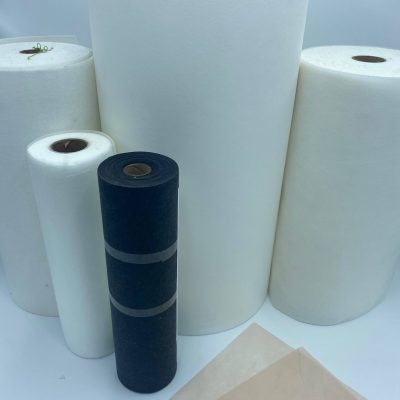
This guide will help answer these questions and more to help you get more professional results and become a better embroiderer. Now if you’re more of a visual learner, this embroidery stabilizer and toppers video is a great resource as well:
What Brand Of Stabilizer Should You Use?
In general, we recommend that you order your stabilizer from a reliable embroidery source online based on price point, or support your local dealer and use the brand they sell.
Now, in most cases, we shop for stabilizers based on price point, rather than who they’re made by because most stabilizers are created by a handful of main manufacturers and then white-labeled by different embroidery brands. Of course, there are some exceptions to this rule. Mainly, avoid purchasing stabilizers from “big box stores” (such as Walmart or Michaels). Sure, you can get stabilizer probably at a cheaper cost, but when you are contemplating buying from the “big box stores” always keep in mind that old adage, “You get what you pay for”. As a general rule of thumb, if you look at a stabilizer and see lighter areas and darker areas, you can be assured you won’t get a consistent stitch.
Why Is Stabilizer So Important?
Stabilizer is the foundation of your embroidery and is a necessity to support your fabric and thread. Without the use of the proper stabilizer the registration of the design may be off, you might have puckering, and your fabric may distort. Your choice of stabilizer can “make or break” your stitch out.
Commercial embroiderers always used a Tear Away or Cut Away backing, and they used a wash away product on top of fabrics that had a nap or raised fibers. Home embroiderers knew they needed something to stabilize their fabric, so they became very creative. They used coffee filters, typing paper, saran wrap, paper towels, wrapping paper, etc. and wondered why their stitches didn’t line up correctly and their fabric puckered. Usually, the first thought is to blame the machine or the way the design was digitized. Although a poorly digitized design is often the culprit, remember that you will always struggle to get quality results if there is a lack of proper stabilization. To this day, we still hear of embroiderers using those products and wonder why they skimp on one of the most important aspects of embroidery.
The Main Types of Embroidery Stabilizers and When to Use Them
Technically, there are only three types of embroidery stabilizers:
- Tear Away
- Wash Away
- Cut Away
Each of these three types of stabilizers may also be available as a fusible and or tacky. When making your decision on which type of stabilizer to use a good rule of thumb is to:
- Use Cut Away stabilizer if the fabric has any stretch – t-shirts, sweatshirts, knits, etc.
- Use a Tear Away Stabilizer if the fabric is stable woven.
- Use a Wash Away if using a sheer fabric or freestanding lace design such as our Vintage Lace, 3D Flowers, 3D Butterflies, or 3D Leaves, etc.
- And whenever possible, fuse your stabilizer to the fabric.
In addition to the three types of stabilizers, most brands also have specialty products to use in your embroidery. This includes fabric preps that help stabilize fabrics that unravel, distort, or pucker. However, it adds stitch counts to your fabric, so it’s ideal to use with a heavy stitch count design. There are also products that add varying textures. They add a firm shape or a soft foam shape, which help with applique without adding any bulk, and cover the stitches so they won’t irritate your skin. These products do not replace stabilizer by any means, but can all be used with tear away or cut away stabilizers.
1. Tear Away Embroidery Stabilizer
Tear Away stabilizers are used for any stable woven fabric that doesn’t stretch. It is what you want to use for towels, leather, vinyl, etc.
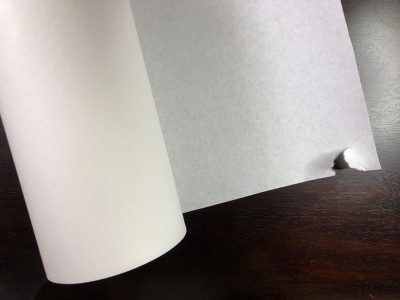
Most Tear Away, tears away very clean (hence the name). Just make sure when you start tearing it away, you place your finger on the stitches and tear it away from the stitch instead of toward the stitch. Like Cut Away stabilizers, Tear Away comes in different weights. Use a heavier stabilizer with a thicker fabric and higher stitch count design. Use a lighter stabilizer with a lightweight fabric and lower stitch count design.
Most brands have water activated and tacky tear away for holding hard-to-hoop items in place, such as towels, the corner of napkins, collars, cuffs, or any fabric that might be damaged in the hooping process. It’s great to use when making bags and In-the-Hoop projects.
2. Wash Away Embroidery Stabilizers
Wash Away stabilizers are used for any sheer fabrics, like organza, that you wouldn’t want stabilizer to shadow through. It’s the perfect choice for freestanding lace, 3D, and cutwork designs. Click here to see some of our designs.
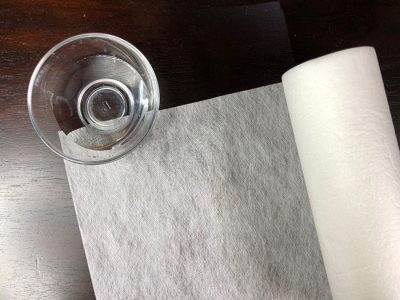
When you have finished embroidering, trim away the excess stabilizer and rinse the design in warm water. There are different types of water, some are harder than others, and that could have a bearing on removing the stabilizer. To test yours, put the stabilizer under running water. If the stabilizer doesn’t start disappearing immediately, you can add a bit of hair conditioner, Calgon bath powder, or fabric softener to your warm water to aid in removing the stabilizer.
For freestanding lace designs you would want to remove the entire stabilizer so the lace is nice and soft. Click here for a complete tutorial on how to properly embroidery freestanding lace designs. For a 3D project embroidery designs, you may want to remove just enough of the stabilizer so you don’t see it.
3. Cut Away Embroidery Stabilizers
Cut Away Stabilizers are the most stable of all of the stabilizers and are permanent. They will continue to support your stitches for the life of the project. Cut Away is always a good choice for any project that will be worn and washed regularly.
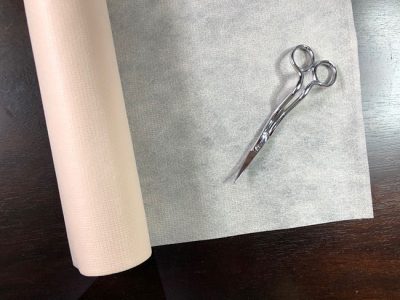
Most brands have different weights of Cut Away – Heavy, Medium, or Mesh. The heavier the stabilizer, the more stitches it will support. Different brands base the type of stabilizer you should use and the number of layers of stabilizer with the stitch count of the design. In our opinion, you should never have more than three layers of product under your fabric. If you check out our Large Legacy Designs, which can be found by clicking here, you will see some of our designs have upwards of 300,000 stitches (given the incredible amount of detail digitized into them). The last thing you would want is to add a heavy stabilizer to an already heavy design, but you need the support more than ever, so what do you do? One of our fan-favorite designs is the Dolphin Scene, which can be found by clicking here. It has 280,954 stitches in the 13”x15” design… no, that’s not a typo, it really has 280,954 stitches. We wanted to stitch the design on a Quilter’s Cotton, so the first thing we did was fuse a fabric prep to the back of the fabric to help prevent puckering. We also fused a Mesh Cut Away to the fabric.
Fusing the stabilizer not only prevents puckering but helps with keeping the registration or alignment of your stitches aligned.
Remember, fuse your stabilizer whenever possible. After we hooped the fabric, we decided to float another layer of Mesh Cut Away under the hoop by gently lifting the hoop’s corner and sliding the mesh under the hoop at a 45° angle. We then secured the topper in place. When the design finished stitching, beautifully I might add, we trimmed away the mesh that was floated close to the stitching line. We then gently released the fusible mesh and trimmed it close to the stitching and left the fabric prep in place. If you have issues releasing a fusible stabilizer, you can lightly press it to release it.
Mesh Cut Away Stabilizer
With most apparel, our go-to stabilizer is a Mesh Cut Away. When embroidering on any fabric with stretch, you always want to use a fusible mesh to prevent the fabric from stretching and puckering. You have two options for hooping a stretchy fabric (like t-shirts, sweatshirts, onesies, etc.)
- You can cut your fusible stabilizer the size needed for your hoop. For instance, if you are using a 5″ x 7″ hoop, you would cut your stabilizer 10″ x 12″ and fuse it to the back of your garment and place it in your hoop.
- Another great method is to cut our mesh stabilizer a few inches larger than the design. Turn your t-shirt, for instance, inside out and fuse the stabilizer to the back of the t-shirt where the design will stitch. Hoop a Tacky Tear Away Stabilizer drum-tight, score the protective paper, and remove it from the hoop. You now have a tacky surface to hold your t-shirt in place. With the t-shirt still inside out, line it up with the markings in your hoop and smooth it out. You can then tape or pin the fabric out of the stitching area without worrying about stitching the front to the back. Place your topper of choice over the area to be stitched, secure it in place, and stitch your design. This is a great solution if you’re worried about hoop burn, pinholes from hooping too tightly, or damaging the garment somehow. For more tips on how to embroider a tshirt, click here.
Embroidery Toppings
The most important specialty product is Toppings. Toppings can be Water Soluble or Heat Away and are both used to place a barrier between your stitches and the fabric, so your stitches don’t disappear. You shouldn’t hoop your topping, but you do have to secure it. We suggest cutting a piece a bit larger than the embroidery design, and then securing it to the area to you’ll be stitching. You can do this by moistening the water soluble topper, pin it, or, as we prefer, tape it in the corners to hold it in place. A water soluble topping tears away very easily and disappears completely once it has been wet. A heat away topping also tears away very easily but requires direct heat from an iron or a press to disappear. For that reason, heat away is our topping of choice.
Get in the habit of using a topping on everything you embroider, and you’ll see a huge difference in your finished product.
We know that with washing and drying, our design is still supported, so the nap of the fabric can’t work its way through the design. If you have small areas of a design, such as the letters; o, b, or d, it can be hard for you to heat press the topping. We suggest to use the tip of your iron set on a silk setting and touch those areas. Then the topping will disappear.
Guide Conclusion: You Need All 3 Types of Embroidery Stabilizer
Stabilizers come in different sizes and colors, and are used for different fabrics and design types. Depending on what you embroider, you do need the 3 main types of stabilizer:
- Tear Away: used for any stable woven fabric that doesn’t stretch, such as leather, towels, vinyl
- Wash Away: used for any sheer fabrics, such as organza, freestanding lace, 3D and cutwork designs
- Cut Away: used for products that are worn and washed regularly. The most stable and good to use for heavy designs with large stitch counts.
As you’ve now learned, using the proper stabilizer is a crucial step towards achieving a perfect sew out and by applying the knowledge found in this guide, you too can get great results! If you’d like to test what you’ve learned, we offer close to 30,000 quality embroidery designs for you to choose from. Or, you can try us free with our Free Embroidery Legacy Design Kit. Happy stitching!
P.S. Want to learn more about embroidery basics? Check out our Machine Embroidery for Beginner’s Guide.

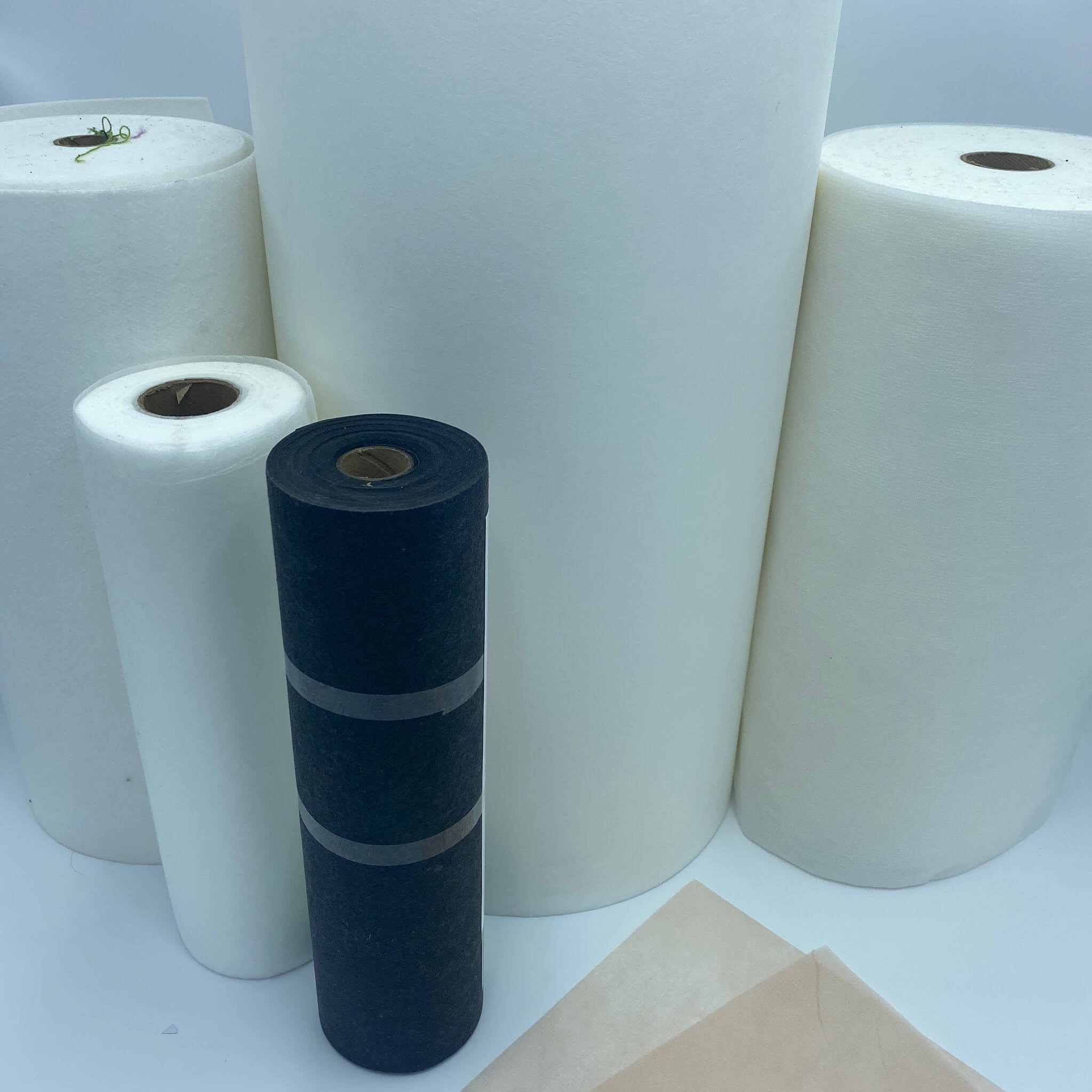
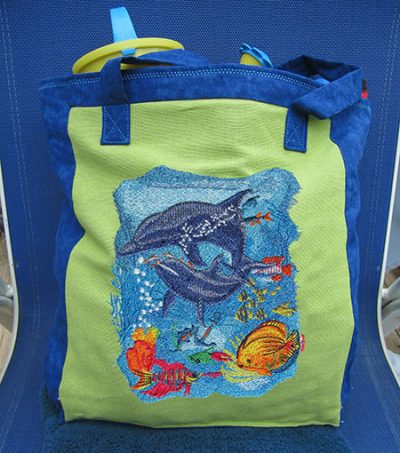
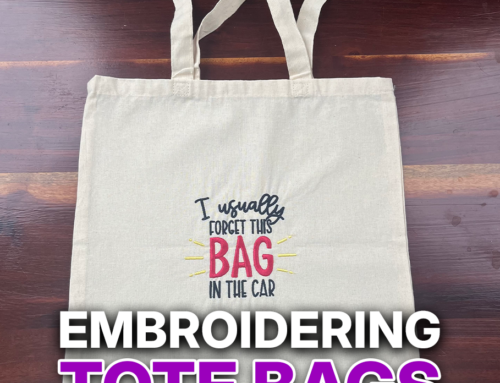
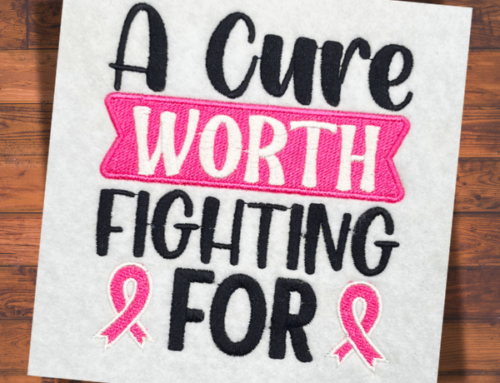

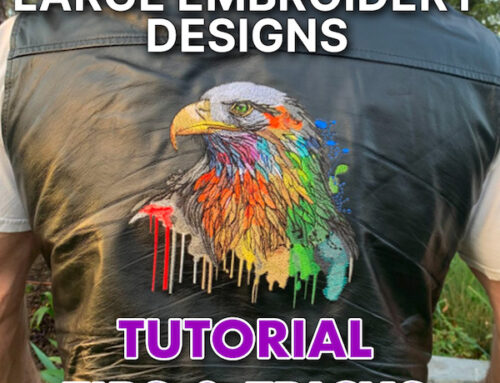
I still found stabilizer choice confusing in this article. I understand the 3 types, but when you say “always fuse” what do you mean or how do you do it. Do you mean put a topper on everything you embroider, everything? Sometimes ir said for very dense stitches use the heavier stabilizer but then you said you used mesh.
Maybe I just need to reread it. Thanks for allowing comments.
Hi Linda,
Fusing is regarding the use of fusible no show mesh.
Toppings will only need to be used on knitted and fabrics with a high pile.
Hope that helps 🙂
What type of stabilizer do you recommend for hats-ball caps etc.?
Hi Cathy, I would recommend using a tear-away stabilizer for hats 🙂
What do you recommend using with performance clothing like under armor?
Hi Gina,
I would recommend using no-show mesh fusible.
Thank you John for this easy to understand tutorial. I just wished I had this knowledge a couple of years ago when I first started to embroider on my machine. I was always a little nervous of using the stabilisers because there were so many makes and types on the market, I just did not know the ‘rules’ for their particular application. Am I able to print off these guides to keep with me when I am in the process of choosing the correct stabiliser to use? Many thanks for your time and for sharing your knowledge with us all; I am truely grateful.
My pleasure Gill! Of course, feel free to print them off and refer to them when needed.
Hello John – I love your website and amazing information on getting the best results. You mentioned fabric prep – is this referring to the additional stabilizers you fuse to the fabric or something else?
Thank you Jackie! Some fabrics may require iron on stabilizer, or topping stabilizer for high pile fabrics, you may want to add fray check if your fabric is prone to fraying. Some stabilizers give you “special effects” like Heat n Shrink. You will need to consider which stabilizer is best for the fabric and project you are sewing out.
What type of stabilizer for doing crewel work embroidery. I am using linen.
Hi Caroline, crewel work embroidery is a hand embroidery technique, so I feel its best to inquire with a group that specifically does that technique. If its machine embroidery designs with a Crewel look then I’d suggest using an no-show mesh stabilizer as its soft, thin and strong.
Can you please tell me what type of stabilizer I would use on the back of the design , so the design fells nice and soft when someone is wearing it and is there one that I can use on any type of fabric that can be worn?
Hi Irene, many companies have a fusible backing that is specific for that purpose. Here is a link of one companies products. https://www.madeirausa.com/e-zee-finishers/
Hi John,
Thank you for this great information. I am making a quilt with machine embroidery/appliqued blocks on cotton. For the blocks do I use cut away and then trim away from the sides? I trimmed around the design and it left an indention. I still got some puckering even though I prepared the fabric with shape-flex. Ideas on how to prevent puckering. The designs are machine applique.
Thank you!
Hi Janet, great question. For quilt blocks my favorite is no-show mesh fusible and leave it fused to the material.
Can you use a standard tear away stabiliser on top of pile material or fake fur?
Hi Sarah, I would not. I’d use water soluble topping (Solvy).
How do we know what weight stabilizer to use? I’m doing a row along the bottom of a microfiber curtain 63” long. It’s a medium weight curtain, what weight do I use? The design is approx 3” x 5” and each panel will have 9 of them in a row on the bottom.
Hi Terry, most stabilizer brands will have a suggested guideline pdf for their various products. Is is hard for me to say as there are so many brands and material may need specific products. My initial thought would be a tear-away/wash-away but I suggest posting your question in our group to see what other embroiderers suggest.
Hi John,
I am machine embroidering hoodies, I know to use the cut away stabilizer. But do I need to use a stabilizer on top of the hoodie as well?
Hi Linda, usually not necessary. Some people feel using a WS topping increase the quality on loosely knitted fabrics.
Which type stabilizer do you recommend for logos on polyester/cotton shirts? The logo is 3.53×2.27 inches and has 6802 stitches. I really appreciate your help on this. I am stitching logos on a special needs shirt for my son.
Hi Sonna, my choice would be no-show mesh. I’d suggest posting in our Facebook group to see what other embroiderers suggest 🙂 https://www.facebook.com/groups/EmbroideryLegacy
I use a 6 needle embroidery machine. I am having issues with the fabric (1. a cotton shirt and 2. a bandana) puckering. I am embroidering two totally different designs, one on each. I hoop my fabrics, stabilized with two layers of fused no-show stabilizer and make sure my fabric in the hoop is drum tight before I begin embroidering. I am still experiencing puckering. What am I doing wrong please?
Hi Priscilla, sorry it’s hard to assess without visuals. Can you please provide a picture of the finished items. Feel free to PM us on Facebook
Is it possible to embroider, using mesh cut Away – fusible – on stretch suspenders? The suspenders are 2 inches wide. If so, would it be necessary to use a topper? What type and weight thread would you suggest? Finally, what type of design/ lettering would be best? # of stitches? Thank you.
Hi Pat, I don’t think using a fusible stabilizer would be wise and a “stretchy” material. I’d use 40wt thread and the designs would depend on what would fit within the area to be embroidered.
Can two sheets of 1.8oz stabilizer be substituted for one sheet of 3.6oz stabilizer of the same type? Or is the issue more complex than that? (I’ve asked this question on several online forums and no one has answered. Either it’s an incredibly dumb question, or people really aren’t sure.)
Hi Stephen, there’s no such thing as a dumb question! I don’t see why not and give it a try. 1+1 still equals 2 in my books 🙂
Im embroidering a heavy canvas bag with a design of heavy stitches. My question is what stabilizer should i use? It seems when i stitch with a tear away I break a needle. help please.Thank you in advance!Marie
That’s odd Marie! Maybe try a light weight cutaway
Marie, By any chance is the canvas coated? Sometimes you can feel it or notice a powdery residue when you cut it or stitch thru it. Personally, I wouldn’t want that stuff inside my machine & would opt to make a patch.
You might try switching to a larger needle.
I find medium-to-heavy canvas doesn’t usually need any stabilizer – unless it has a bit of stretch, in which case I would definitely use a light-wt tearaway, as John suggested. (I would not use water-soluble unless you don’t mind rinsing it away — in that case, Heat Away could work.
When embroidering on a tee shirt, what is the best stabilizer to use so there is no puckering?
Hi Deb, we suggest no show mesh fusible and a water soluble topping 🙂
There has been an on-going conversation on several FB groups about whether to pre-shrink mesh stabilizer. In some circumstances I will steam the mesh to avoid puckering & others wash & dry it. I have done some research & learned that mesh is either nylon or polyester (not all brands tell you). Can you help clear up the confusion.?
Hi Karen, I’ve personally never pre-washed any of my stabilizers. Properly hooped and digitized designs are the first steps in reducing puckering.
Embroidering on a 100% waffle cotton baby blanket. I’m going to use a medium weight Heat2Go on the top, but I’m not sure what to use on the bottom. Can I use the Heat2Go on the bottom or do I need something heavier so it doesn’t pucker? I want something that will not be stiff or highly visible on the back. Thanks!
Hi Eileen, generally for the back of blankets I like using a Tear-Away/Wash-Away stabilizer, it tears away and any residue left dissipates within the laundering.
Hello I’m new to embroidery and my question is. When making patches using canvas or duck fabric. What is the best stabilizer to use and what should the weight of the stabilizer be? Thank you.
Hi Helen. Great questions! We have two helpful blogs for making patches here 🙂 https://www.digitizingmadeeasy.com/how-to-make-custom-embroidery-patches/ & https://www.digitizingmadeeasy.com/supplies-needed-machine-embroidery-patches/
What stabalizer should I use with a design calling for a fusible fleece stabalizer
Hi Nancy, for fleece, I would usually us a medium-weight cut-away or no-show mesh. Be sure to use a water-soluble topper as well.
What stabilizer do you recommend on each of these: linen, polyester and cotton napkins? Thanks!
Linen- medium weight cut-away.
Polyester- no-show mesh
Cotton Napkins- tear-away/wash-away.
I am trying to embroider a design on 2 layers of quilting cotton. The design is quite dense.
I have tried starching the top layer, press on wash away stabilizer, and my last attempt was starch & 2 layers of light weight stabilizer as well as changing the density.
I’ve done 3 attempts & thought I’d ask before a) ripping my hair out or b) buying another design (this one is perfect for my project)
It keeps puckering.
Any suggestions?
Hi Ann, two suggestions; be sure you’re hooping and not floating, and try using fusible interfacing to give the fabric more stability and structure.
What stabilizers should I use on inexpensive beach towels?
Tear-away/wash-away would be my choice.
Hello!
I’ve just started in the embroidery business, I’ve started with something simple, patches on twill I’ve been using two layers of stabilizer cut away 1.5 oz however I’ve noticed how some designs wrinkle the twill some patches are incredibly detailed up to 20,000 stitches in an area of 4in.x 3in. I’ve started thinking about using three layers of 1.5 oz cut away stabilizer.
But I’ve wondered if it would be better to use a 2.5 oz or 3.0 oz cut away stabilizer and put only two layers on or stick with the idea of using three layers of 1.5 oz cut away stabilizer.
Please any help will be very appreciated, thank you.
Hi Fernando, I would suggest cutaway stabilizer in the first place. I would also suggest watching our free embroidery patches webinar https://www.digitizingmadeeasy.com/custom-embroidery-patches/
When a stabilizer weight is mentioned, such as 1.5 oz, does this refer to a square foot, square yard or what? Thank you.
That refers to the “thickness” of the stabilizer 🙂
What type of stabilizer is used for sweatshirts, silk bomber jackets and hats?
Hi Nicole, for sweatshirts I prefer no-show mesh, silk bomber would be medium weight cut-away and caps tear-away.
Where can I order the Heat and Gone Stabilizer?
Hi Terri, the brand I have used successfully is Floriani which can be purchased at Sewing Machine Retailer and some online resellers.
Hi, John!
I have a question I’m hoping you can help with. I have scoured the internet and can find a cause for my issue, but not a solution.
Sweatshirts and permanent wrinkles in fabric once laundered … ugh!
I have a perfectly stitched out design with no puckers, etc., but after a wash, I have major wrinkles in the fabric wherever the stabilizer is touching my fabric. I’ve tried cutting the stabilizer off as much as possible, ironing, prewashing the sweatshirt, etc., but no one has time for all of that.
It’s clear to me the stabilizer is shrinking and causing the wrinkles, so my question to you is do you have a suggestion as to a stabilizer that won’t shrink once washed OR do you have any suggestions on how to pre-shrink the stabilizer before using it?
Thank you so much for your time!
I appreciate you!
Hi Denise, do you experience this with multiple brands? Is it the stabilizer or the garment thats shrinking. A fibrous cut-away stabilizer should not shrink so much that it affects a woven material. Another suggestion would be to try different stabilizers to see which give you best results.
The information is great. And Im a bit overwhelmed with all this. Im getting my first embroidery/ sewing machine. I want to practice lots. Tight budget. So what would be the best stabilizer to try first? As i want to glowers add to this. Thank You.
Hi Joy, I would start with a standard cut-away and tear-away, those two are enough to get started.
I have about an 8 inch square heavy density design that I need to embroider on duct cloth for an apron. What do you reccommend to use for stablilizing this and would you float or hoop the fabric? I assume a sharp needle would be the best or would a 75 embroidery needle work as well. Open for suggestions.
Thank you very much.
Hi Terry, preferably a cut away stabilizer, fusible interfacing on material would help. Hooped, not floated. Standard 75/11 is fine.
What stabilizer should be used on organza? Thank you for your wonderful and helpful teaching and advice. I just thought I knew embroidery until I started taking your courses and watching all your YouTube videos!!
Hi Janice, I find using one layer of wet-and-gone, wash-away stabilizer works best for organza.